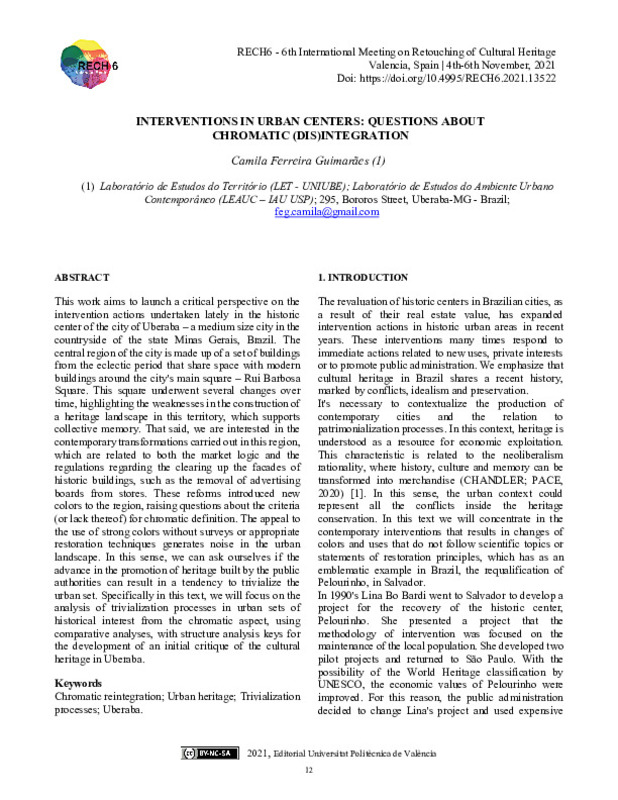JavaScript is disabled for your browser. Some features of this site may not work without it.
Buscar en RiuNet
Listar
Mi cuenta
Estadísticas
Ayuda RiuNet
Admin. UPV
Interventions in urban centers: questions about chromatic (dis)integration
Mostrar el registro sencillo del ítem
Ficheros en el ítem
| dc.contributor.author | Guimarães, Camila
|
es_ES |
| dc.date.accessioned | 2023-01-19T08:53:47Z | |
| dc.date.available | 2023-01-19T08:53:47Z | |
| dc.date.issued | 2023-01-11 | |
| dc.identifier.isbn | 9788413960258 | |
| dc.identifier.uri | http://hdl.handle.net/10251/191400 | |
| dc.description.abstract | [ES] Este trabajo pretende exponer una perspectiva crítica sobre las acciones de intervención realizadas últimamente en el centro histórico de la ciudad de Uberaba - una ciudad de tamaño medio en el interior del estado de Minas Gerais, Brasil. La región central de la ciudad está formada por un conjunto de edificios de la época ecléctica que comparten espacio con edificios modernos en torno a la plaza principal de la ciudad - la plaza Rui Barbosa. Esta plaza sufrió varias transformaciones a lo largo del tiempo, lo que pone de manifiesto la debilidad de la construcción de un paisaje patrimonial en este territorio, soporte de la memoria colectiva. Dicho esto, interesan mostrar las transformaciones contemporáneas llevadas a cabo en esta región, relacionadas tanto con la lógica del mercado como con las normativas relativas al saneamiento de las fachadas de los edificios históricos, como la retirada de los carteles publicitarios de las tiendas. Estas reformas introdujeron nuevos colores en la región, planteando cuestiones sobre los criterios (o la falta de ellos) de definición cromática. La apelación al uso de colores fuertes sin estudios ni técnicas de restauración adecuadas genera ruido en el paisaje urbano. En este sentido, podemos preguntarnos si el avance en la promoción del patrimonio construido por parte de los poderes públicos puede derivar en una tendencia a la banalización del conjunto urbano. Específicamente en este texto, nos centraremos en el análisis de los procesos de banalización en conjuntos urbanos de interés histórico desde el aspecto cromático, utilizando análisis comparativos, con claves de análisis de estructura para el desarrollo de una crítica inicial del patrimonio cultural en Uberaba | es_ES |
| dc.description.abstract | [EN] This work aims to launch a critical perspective on the intervention actions undertaken lately in the historic center of the city of Uberaba – a medium size city in the countryside of the state Minas Gerais, Brazil. The central region of the city is made up of a set of buildings from the eclectic period that share space with modern buildings around the city's main square – Rui Barbosa Square. This square underwent several changes over time, highlighting the weaknesses in the construction of a heritage landscape in this territory, which supports collective memory. That said, we are interested in the contemporary transformations carried out in this region, which are related to both the market logic and the regulations regarding the clearing up the facades of historic buildings, such as the removal of advertising boards from stores. These reforms introduced new colors to the region, raising questions about the criteria (or lack thereof) for chromatic definition. The appeal to the use of strong colors without surveys or appropriate restoration techniques generates noise in the urban landscape. In this sense, we can ask ourselves if the advance in the promotion of heritage built by the public authorities can result in a tendency to trivialize the urban set. Specifically in this text, we will focus on the analysis of trivialization processes in urban sets of historical interest from the chromatic aspect, using comparative analyses, with structure analysis keys for the development of an initial critique of the cultural heritage in Uberaba. | es_ES |
| dc.format.extent | 6 | es_ES |
| dc.language | Inglés | es_ES |
| dc.publisher | Editorial Universitat Politècnica de València | es_ES |
| dc.relation.ispartof | 6th International Meeting on Retouching of Cultural Heritage, RECH6 | |
| dc.rights | Reconocimiento - No comercial - Compartir igual (by-nc-sa) | es_ES |
| dc.subject | Desintegración cromática | es_ES |
| dc.subject | Trivialización | es_ES |
| dc.subject | Patrimonio urbano | es_ES |
| dc.subject | Centros históricos | es_ES |
| dc.subject | Restauración de patrimonio arquitectónico | es_ES |
| dc.subject | Intervención urbanística | es_ES |
| dc.subject | Urban Heritage | es_ES |
| dc.subject | Trivialization | es_ES |
| dc.subject | Chromatic disintegration | es_ES |
| dc.subject | Urban planning intervention | es_ES |
| dc.subject | Restoration of architectural heritage | es_ES |
| dc.subject | Historical centers | es_ES |
| dc.title | Interventions in urban centers: questions about chromatic (dis)integration | es_ES |
| dc.type | Capítulo de libro | es_ES |
| dc.type | Comunicación en congreso | es_ES |
| dc.identifier.doi | 10.4995/RECH6.2021.13522 | |
| dc.rights.accessRights | Abierto | es_ES |
| dc.description.bibliographicCitation | Guimarães, C. (2023). Interventions in urban centers: questions about chromatic (dis)integration. En 6th International Meeting on Retouching of Cultural Heritage, RECH6. Editorial Universitat Politècnica de València. 12-17. https://doi.org/10.4995/RECH6.2021.13522 | es_ES |
| dc.description.accrualMethod | OCS | es_ES |
| dc.relation.conferencename | RECH6 - 6th International Meeting on Retouching of Cultural Heritage | es_ES |
| dc.relation.conferencedate | Noviembre 04-05, 2021 | es_ES |
| dc.relation.conferenceplace | Valencia, España | es_ES |
| dc.relation.publisherversion | http://ocs.editorial.upv.es/index.php/RECH/RECH6/paper/view/13522 | es_ES |
| dc.description.upvformatpinicio | 12 | es_ES |
| dc.description.upvformatpfin | 17 | es_ES |
| dc.type.version | info:eu-repo/semantics/publishedVersion | es_ES |
| dc.relation.pasarela | OCS\13522 | es_ES |








